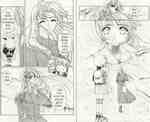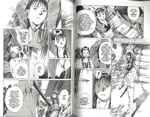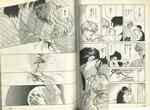|
Manga
in Japan
Manga
("comics") is a tremendously popular medium in Japan,
and is often exported worldwide along with its upstart cousin, anime.
But manga differs from American and European-style comics, wherein
the medium often presupposes audience and content.
Manga sales
amount to over five billion US dollars annually in Japan. For the
past twenty years, at least a third of all books and magazines published
in Japan are manga. Popular manga magazines have regular circulation
of over a million.
It's a huge
business.
Manga is published
primarily in magazines - usually weekly or monthly - containing
over 300 pages of comics. A magazine will be targeted at a specific
audience, such as boys, history buffs, homemakers, or businessmen,
and a single issue will contain new episodes of ten to twenty ongoing
stories.
Presumably
because of high postal rates and the low quality printing of most
manga, subscriptions are marginal. Most manga magazines and books
are sold in special bookstore sections or public kiosks.
Tankoban are
usually called "graphic novels" in English. They are compilations
of a dozen or so episodes of a single story, printed on higher-quality
paper than the pulpy magazines. Tankoban are popular with collectors
- they receive best-seller status after having sold around two million
copies, as opposed to 100,000 copies for non-manga books.
Popular manga
are also translated and distributed worldwide, making the market
even wider.
Manga
Translation and Sales Around the World
Manga is usually
translated with an eye towards pop-culture appeal; as such, it tends
to be clearly and engagingly translated. Furthermore, many manga
are footnoted or otherwise annotated to explain references to Japanese
history and culture that may be unfamiliar to its non-Japanese readers.
In addition,
translated manga is easily accessible in chain bookstores and specialty
comic shops; many manga have also been translated into other European
languages, primarily Spanish and French.
All About
Flipping
Because written
Japanese is ordered differently than most European languages, books
are organized and comics are drawn to be read in a different fashion
than might be expected.
Japanese text
is generally read from top to bottom and then right to left. For
this reason, books are held with the binding on the right-hand side
and pages are turned to the right instead of to the left. In addition,
the default mode of perception is first vertical, then horizontal.
Due to the
innate marriage between drawn space and perceived time in a comic,
Japanese manga cannot be intuitively scanned by people accustomed
to European languages. While the images will look fine, an English-speaking
(or any other left-to-right reading language) reader will tend to
follow the progression of panels in the wrong order.
To combat this,
most manga is flipped horizontally when it is translated and published
outside of Japan. Generally, this allows for an intuitive reading
of manga. However, the artwork does suffer a little bit. Some styles
of foreshortening and dramatic lighting can look a little bit silly
when flipped.
Recently, there
has been a trend towards publishing manga in English translation
that has not been flipped. The right-to-left orientation of the
artwork is preserved, and with a little bit of practice, it's possible
to train the eye to scan the page 'backwards'.
Unfortunately,
some manga is also translated in a cruder fashion, wherein the panels
are rearranged so as to be read from left to right, but the illustrations
themselves are not flipped. This results in very awkward-looking
pages that are really hard to read.
Examine scans
of non-flipped, flipped, and partially-flipped manga to see the
difference for yourself.
 |
 |
 |
From a Flipped Manga
(Card
Captor Sakura) |
From a Partially Flipped Manga
(Blade of the Immortal) |
From a Non-flipped Manga
(Fake)
|
-Brian Kerr 
References
Ito, Kinko.
"Sexism in Japanese Weekly Comic Magazines for Men." Asian Popular
Culture. Ed. John A. Lent. Boulder: Westview Press, 1995.
Mangajin Magazine. Mangajin's Basic Japanese Through Comics.
New York: Weatherhill, 1998.
McCloud, Scott. Understanding Comics. New York: Paradox Press,
1993.
McCloud, Scott. Reinventing Comics. New York: Paradox Press,
2000.
|















